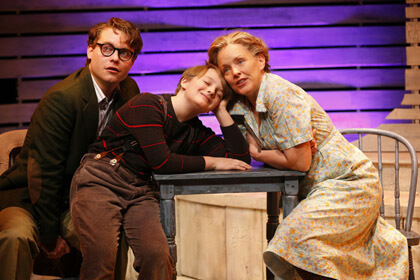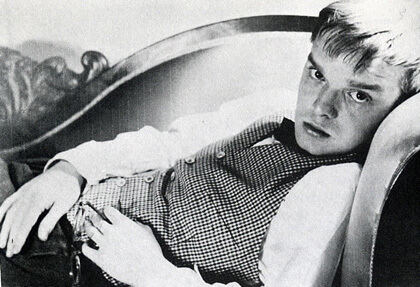Selfies taken by Cecil Beaton in his late teens. | ZEITGEIST FILMS
Lisa Immordino Vreeland’s “Love, Cecil” is an affectionate documentary portrait about the famous gay British author, designer, painter, and photographer Cecil Beaton (1904-1980). The film is a magnificent showcase for Beaton’s work as well as his thoughts about style and his impressions of people — he candidly refers to Katharine Hepburn as “a dried-up boot.” Through his copious diary entries (some of which are read aloud by out gay narrator Rupert Everett) as well as candid archival interviews with Beaton himself, the film presents a man who is absolutely captivating — even when he talks about his hat.
“Love, Cecil” is a conventionally-made documentary in that it traces the life, education, relationships, and work of its subject. Immordino Vreeland features talking-head commentaries by many contemporaries who knew him. Beaton’s struggles and career highs and lows are addressed. And there are hundreds of fabulous images, film clips, scrapbooks, diaries, and illustrations that put his life and career in perspective. Immordino Vreeland smartly juxtaposes images such as his sisters indulging in their brother’s penchant for dress up to show the Beaton’s genius in style, composition, and costume.
Style was key to Beaton. His breathtaking portraits are, as observed at one point in the film, “about the idea of the person, not the actual person.” The film uses the glorious photos Beaton took of everyone from Edith Sitwell and the Bright Young Things in the 1930s to Queen Elizabeth’s coronation in 1953 and Mick Jagger in the ‘60s to underscore this point and emphasize Beaton’s triumphs in capturing the essence of the new and modern.
Cecil Beaton’s life explored, triumphs and troubles
His portraits are legendary. Especially impressive are a series of images he shot of Greta Garbo for Vogue. That photo shoot led to a disagreement between the actress and the photographer, resolved months later and rumored to include romantic fumblings.
Garbo, “Love, Cecil” explains, was one of Beaton’s three great loves. The other two were men. One was Peter Watson, with whom Beaton had a “troubled affair” when both were young. Watson did not reciprocate Beaton’s feelings and he did not allow him to touch him. Watson preferred the affections of one of Beaton’s rivals. The artist’s other great love — reportedly the last in his life — was the strapping Olympic fencer Kin Hoitsma; but it did not last. In the film, Beaton describes himself as “a terrible homosexualist,” and his insecurities are addressed along with his complicated relationship with his father, who once discovered Cecil in a dress and makeup.
Immordino Vreeland’s film includes clips of Cecil in drag from his Bright Young Things days, as well as pointed remarks about him being “an outsider struggling to get in” to the upper-class world just outside his reach. That may be what sparked his interest in celebrity. His copious self-portraits, displayed throughout the film, hint at the loneliness he experienced throughout his life. One subtext of Immordino Vreeland’s film is that despite Beaton’s unerring ability to preserve a fleeting moment on film, he rarely received the depth of love he freely offered through his lens.
“Love, Cecil” also suggests the artist may have been his own worst enemy. Case in point was a “thoughtless, arrogant” image Beaton published in “Vogue” that was found to have included a tiny anti-Semitic scrawl on its border. Its discovery caused the magazine to pulp the issue and fire him. That self-destructive behavior and the shame he endured derailed his career for a year and a half before he redeemed himself during the war years. Beaton shot images such as an injured child for the cover of Life magazine to help convince America to back Britain’s war efforts. Other wartime photographs included homoerotic shots of airmen, soldiers, and other military men, and Immordino Vreeland includes several of those delicious images in the film.
“Love, Cecil” also features some gossip. Truman Capote and Diana Vreeland (the director’s grandmother-in-law) are seen debating Beaton in one film clip. Another interview has Beaton admitting he was jealous of the success of Nöel Coward, and counts him along with Evelyn Waugh among his enemies. Beaton also didn’t like the Burtons (Liz and Dick), calling them vulgar. His exquisite costumes and production design for “My Fair Lady” won him two Oscars, but Immordino Vreeland’s film reveals that Beaton and director George Cukor, another gay man, did not get along at all. Beaton found Hollywood suffocating.
These dishy moments are enjoyable and may get at the real Beaton. Tart remarks he makes about a weekend guest he loathed but embraced, about David Bailey’s 1971 documentary “Beaton by Bailey,” and about being knighted also point up his sour disposition.
“Love, Cecil’ is certainly no hagiography, as Immordino Vreeland managed to celebrate its subject, warts and all. She uses Beaton’s remarkable, imaginative vision and images to show him living his truth by being himself. He may have been a vain, mercurial figure — someone who created a fantasy world to deal with the unhappy reality he found himself in — but there is no denying his exceptional talent.
LOVE, CECIL | Directed by Lisa Immordino Vreeland | Zeitgeist Films | Opens Jun, 29 | Film Society of Lincoln Center, Elinor Bunin Munroe Film Center, 144 W. 65th St. | filmlinc.org



































